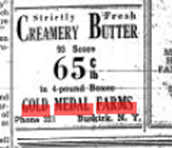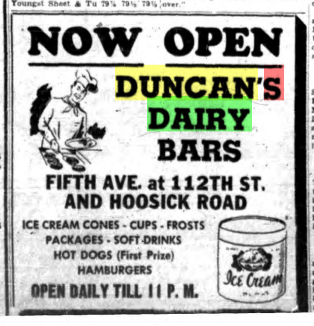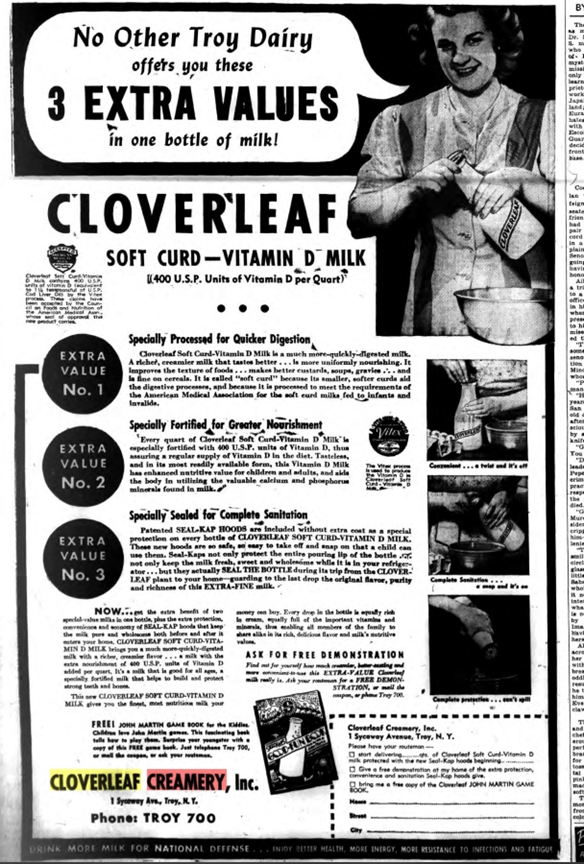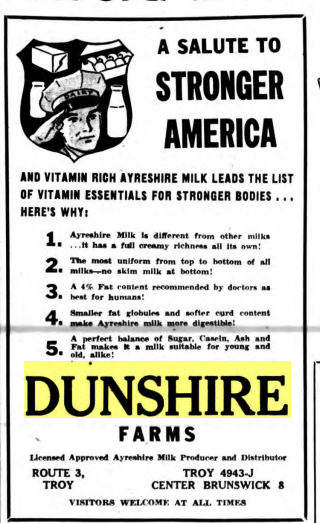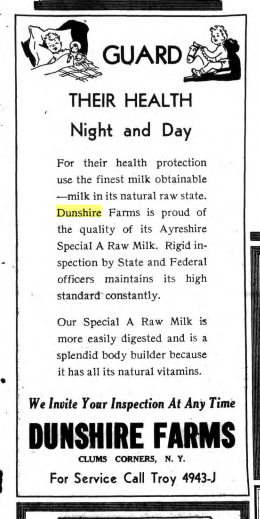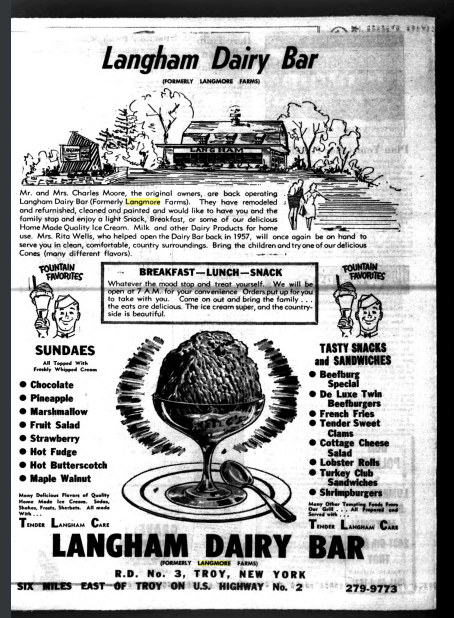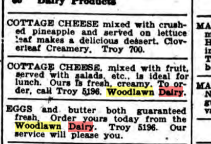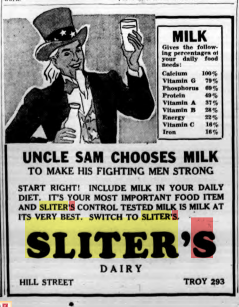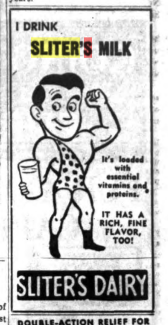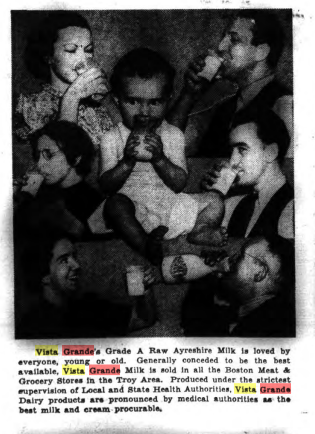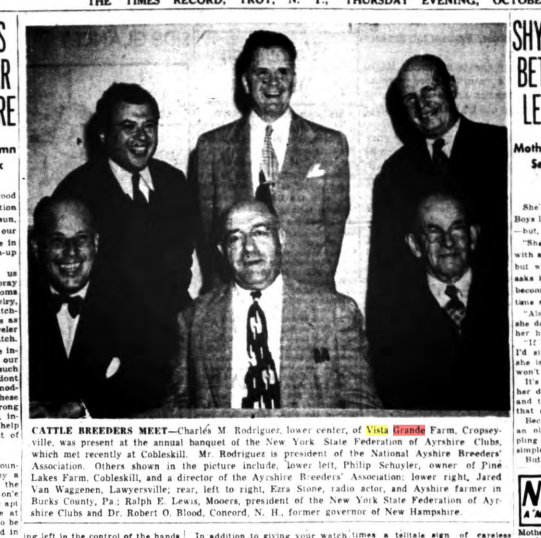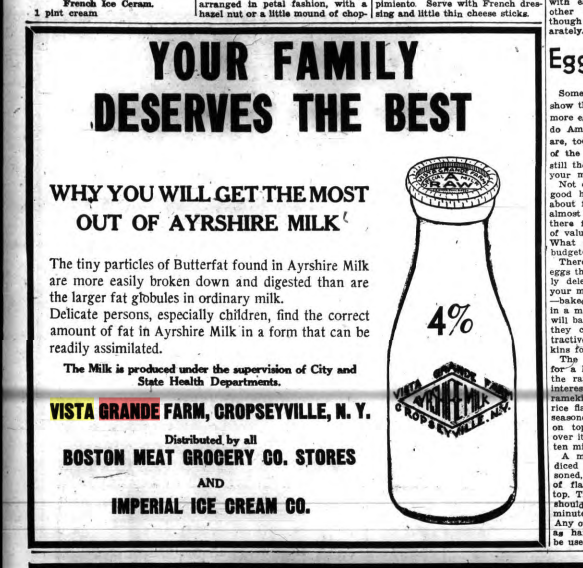Milk in Rensselaer County
milk production and transport
Throughout the 18th and 19th centuries, every farm in Rensselaer County had a cow or two for domestic use, with some farms having additional cows so that surplus milk and milk products could be sold. Farm wives were often in charge of making milk into butter or cheese. Without refrigeration, most milk was processed into one or the other to make it last longer. The story of the commercialization of milk production in Rensselaer County is too big for one blog post, but there were two major models in use.
Some milk was bottled or processed into butter and cheese for local sale. Organized creameries were founded in the county at the end of the 19th century by individuals and cooperative groups. Cream was skimmed off the top of milk pans at the farms for delivery to the creamery until cream separators came into wide use in the 1890s. One example of this in Rensselaer County was the Schaghticoke Creamery, incorporated in 1888. Directors and cousins J. Irving and J. Bryan Baucus were businessmen while the other directors were farmers. In 1897, the Creamery produced about 107,00 pounds of butter with milk from about 100 local farmers, who split the profits. The creamery also made buttermilk and delivered cream via routeman.
Lots of milk was collected for shipment to New York City. Farmers in eastern Rensselaer County supplied milk to New York by rail beginning in 1869, via the Corkscrew Division of the Rutland Railroad to Chatham, NY, then on to the Harlem Railroad to New York City. There were stations at Salem and Cambridge in Washington County, and Eagle Bridge, Petersburg, Berlin, Cherry Plain (South Berlin until 1919), North Stephentown, and Stephentown in Rensselaer County. There were milk receiving stations, called creameries, at least at Buskirk, Eagle Bridge, and Stephentown. Gold Medal Farms, at Buskirk, and Sheffield Farms, at Stephentown, were both very large New York City-based operations. Sheffield had creameries all over eastern New York State. The “milk train” carried passengers too until 1925, but only carried milk thereafter.
At first, the specially-built rail cars were packed with ice to keep the milk cold. Creameries would cut ice on local ponds in the winter to store in their icehouse for use the rest of the year. Some creameries also sent cheese and butter to New York. Refrigeration was modernized over time. The milk train ran until 1952, when tank trucks took its place.
Farmers transported the milk to the creameries themselves, in five-gallon cans. Gradually this practice shifted to milk haulers picking up the cans at the farms, then the cans were replaced by tank trucks. Dairy farmers milked twice a day, so in warm weather the evening milking would have to be kept cool until the deliveryman came the next morning. Before electricity, farmers also had to cut ice on their ponds and store it in their own ice houses to accomplish this.
In 1938, there was a milk strike. The Federal Trade Commission accused the milk dealers of setting unfair prices on milk from the farmers. Gold Medal Farms was a focus of the strike as it was so large. It was accused of preventing its 650 supplying farmers from organizing to do cooperative bargaining with them. At the time, the planted processed 85,000 pounds of milk a day. Farmer unrest continued for the next few years. In 1963, the Washington and Rensselaer County Producers cooperative purchased the plant. There were 223 milk producers in the coop. Gold Medal’s plant burned in 1974.
Creameries/Dairies
William Gow (1862-1919) built one of the first modern milk barns in the county. Gow, a native of Johnsonville, was a successful advertising executive in New York City. He married a local woman, Elizabeth Gifford, and bought a large farm on Master Street in Schaghticoke, called St. Croix Farm, as a weekend retreat and retirement project. He finished a dairy barn in 1913 with 112 stalls, “one of the largest in the state.” He even paid to improve the public roads leading to his farm. The farm grew to 800 acres, “the largest certified milk farm in the state.” The NYS Certified Milk Producers met there in 1916 with 50 farmers present. Sadly, Gow died unexpectedly in 1919, leaving his plans unfinished. The farm was leased to the Borden Company soon after.
The Chatham Republican reported that the Stephentown Creamery opened Monday, March 20, 1893. News articles as late as 1942 reported the workers cutting ice in the winter to cool the milk. The creamery closed in January 1948 when it needed extensive work to comply with NYS health requirements. The farmers then had to send their milk to the North Chatham Creamery in Columbia County.
The Hood Creamery in Eagle Bridge was another receiving station for milk on the milk train route, equipped with a private siding. Hood had a second plant in Salem. In 1946, Hood and Sons built a new plant, a 48’ x 120’ concrete building, one of the largest receiving stations in the East.
Besides the milk receiving stations supplying the milk train and New York City, there were many smaller creameries in Rensselaer County producing dairy products for local use. Among the first modern ones was that of Richard Dixon. He immigrated to the U.S. from Ireland in 1882, working as a coachman in Troy until he purchased a farm in the Melrose area of Schaghticoke around 1900. Dixon’s Dairy bought milk from the neighboring farms, bottled it, and delivered it to residential customers and restaurants, mostly in Lansingburgh. After Richard’s death in 1920, his teenage sons Albert and Thomas took over the business. During World War II, they built a big chicken house and began egg delivery as well. The Dixons transitioned from horse and wagon to truck as soon as they were able. After NYS mandated pasteurizing in 1931, they bought milk from Diamond Rock Creamery in Lansingburgh. Albert continued to run the business until the 1980s.
Another early business was the Brunswick Creamery. It may have begun as a cooperative creamery, similar to the Schaghticoke Creamery, but in 1900 it re-incorporated as a limited stock company. The original building on Moonlawn Road was made into a house in 1916, replaced by a new building.
Eagle Mills Creamery began in 1919 with a milk delivery route, supplied with milk purchased from farmers in Brunswick, delivering in Eagle Mills and Troy. Harold Winne, Sr. took over the business in 1929. He processed milk for other dealers from Center Brunswick, Cropseyville, Grafton, Watervliet, and Green Island, and made ice cream, cottage cheese, and butter. Chemist Arthur Lilly developed Winne’s ice cream for Eagle Mills in 1937. A customer favorite, it was sold at an ice cream parlor in Eagle Mills for 25 years. Harold retired in 1967.
There were several creameries or dairies in Troy, including Brooks Dairy, at 2 Oakwood Avenue, which began in 1938. It grew to have three outlets, much like Stewarts today, and also supplied milk to commercial customers. Collar City Creamery was established in 1925 and purchased by Borden in 1936. Charles Ray Cornell was the long-time plant manager. It was sold in 1954 and is now a pump service and supply company near St. Basil’s Church in Troy.
Another Troy creamery was Diamond Rock. The date of formation is uncertain, but in 1935 the company bought land at 720 6th Avenue to build a new plant. Ads appear in the newspaper for the brand until 1952, when it was sold to the Dairymen’s League Cooperative Association. The brand continued, as did the 45 employees.
Ads appear in the Troy newspaper for products of the Dairylea Creamery at the same address, from 1924 to 1973. There were ads for evaporated milk (1924), milk in tall cans (1932), ice cream (1938), cloverleaf homogenized milk (1946), and nonfat milk solids (1952). The plant was for sale in 1973.
Cloverleaf Creamery on Sycaway Avenue at the Troy/Brunswick border incorporated in December 1929. A 1943 newspaper ad describes it as a subsidiary of the Dairymen’s League, which also owned Diamond Rock. The League was a cooperative association of dairy farmers, begun in 1907. Its products were known under the brand Dairylea. The cooperative had milk plants all over the state. At first, its goal was to get better prices for farmers for their milk, but eventually began processing the milk into everything from sweetened, condensed, evaporated, and powdered milk, to other dairy products.
Troy Times Record July 9, 1966
The Wagar brothers - Freeman, William, Clifford, and Elmer - operated Wagar Brothers Dairy from about 1939-1956. The business continued on under the same name through at least 1966, featuring milk deliveries and a dairy bar on Spring Avenue Extension in Wynantskill. Wagar Brothers sold their place to Moxie and Geraldine Allie in 1970. It is still operated in the summers by the Allie’s daughter Pamela Allie-Morrill, who makes all of her own ice cream.
Sycaway Creamery on Duncan Lane in Brunswick was incorporated as a milk producer and distributor by C. Cecil Duncan in 1936. His father Robert, an Irish immigrant, was farming in Brunswick by 1900. The dairy farm was north of Hoosick Street near Lord Avenue, where the new Hannaford opened in fall 2022. In time, Cecil’s son Keith, who died in 2022, ran the creamery, while son Kent ran the farm. The company began to sell ice cream in 1937 and opened Duncan’s Dairy Bar on Hoosick Street in 1939. Cecil’s brother Robert John Duncan (1909-1997) and his wife Ruth Keller (1909-1989) ran the dairy bar. Ruth’s father Julius ran a bakery and Keller baked goods and recipes were incorporated into the offerings at the dairy bar. Gradually the dairy farm and creamery business shifted to distribution of milk and milk products. Both Sycaway Creamery and Duncan’s Dairy Bar remain vibrant businesses today.
Another creamery with dairy bar in Brunswick is very visible today. The barn-shaped building just to the east of the Brunswick Public Library, home to the Brunswick Children’s Academy, was the dairy bar of Langmore-Dunshire Farms. Around 1930, Horace Dunham became a dairy farmer. Born in Grafton, he lived most of his life in New York City. He was a successful stock broker who became a gentleman farmer. He established a fine herd of Ayrshire cows at his farm at Clums Corners. A newspaper ad suggests that his Dunshire Farms specialized in selling raw milk.
In 1945, Dunham sold the business to Charles J. Moore and his wife Helen. Charles had managed herds in Massachusetts, Pennsylvania, and Loudonville before buying some Guernseys from his employer in Loudonville and moving to Clums Corners. Moore continued both the milk and the dairy bar business of Horace Dunham, advertising “an exclusive extra quality bottle of milk from pure bred Guernseys” that was “produced, pasteurized, and bottled at model Langmore Farms.” Moore auctioned the herd in 1959 but continued to run the dairy bar for several more years, expanding it into a restaurant for a short time. The dairy bar was sold at a tax sale in 1967, and was operated as a couple different restaurants for a few more years.
Edward and Janet Anderson also had a barn-shaped dairy bar, this one in Speigletown in the town of Schaghticoke. Edward (1909-1967) was the son of Swedish immigrants Nelson and Anna Anderson, and grew up in Easton. He had an electrical engineering degree from RPI, but returned to dairy farming, purchasing land in Speigletown. He and Janet (1907-1999) married in 1932. Soon after establishing the farm, he opened Anderson’s Dairy Bar. He replaced the first building with the current one in 1962. It is now the Rustic Barn, a bar and restaurant, right next to the fire department.
Sliter’s Dairy had its headquarters at 231 Hill Street, off Spring Avenue in Troy. The owners were Arthur J. Sliter (1891-1974) and his wife Myrtle (d. 1969), whose farm was off Snyder’s Lake Road, in the North Greenbush/Defreestville area. Though the 1920 US Census lists Arthur as a milk peddler, ads for the dairy appear in the Troy Times Record from about 1935 to 1961. According to her obituary, Myrtle also operated Sliter’s Confectionery on 3rd Street in Troy for many years. Barbara Urban remembers that she specialized in big satin heart boxes of chocolates at Valentine’s Day.
Woodlawn Dairy, owned by Claude Coons (1896-1960), operated from about 1940 until Coons’ death. The address given for the business in newspaper ads is 36 Woodlawn Court, which is off Pawling Avenue in Albia- obviously not the site of a farm. It is now a home.
John A Reehl (1900-1970) and his wife Anna Mae Hogan Reehl (1904-1979) operated Reehl’s Dairy in East Greenbush. Reehl’s obituary stated that he had retired in 1967 after operating a dairy processing plant for almost fifty years.
Troy Times Record December 31, 1960
Charles M. Rodriguez operated a dairy farm called Vista Grande in Cropseyville, and was also the founder of the Boston Meat and Grocery Store chain in Troy. Rodriguez was born in Santander, Spain, moving to Troy as a young man. He married Margaret Hargreaves in 1922 and bought his farm in Cropseyville in 1926. Like Horace Dunham, Rodriguez specialized in Ayrshire cows, which he milked and bred for sale. In the 1940s he was President of the National Ayshire Breeders’ Association and sold his cattle all over the country. On the grocery side, he was President of the Meat Dealers and Grocers Association. Of course his grocery stores sold his milk.
Most of the farms and creameries discussed above mentioned hosting tours for 4H and scouting groups, but Rodriguez really emphasized working with local 4-H clubs, giving calves to members finishing first in various competitions. He really did have una vista grande (a grand vision). Charles died in 1959.
There are still a number of dairy farms in Rensselaer County, though far fewer than in the mid-20th century. The cows of today produce exponentially more milk than those of the past. Copses Farm on Master Street in Schaghticoke is an example of a thoroughly modern 21st century dairy farm, located right next door to St. Croix Farm, the modern dairy farm of the early 20th century. St. Croix is now a meat farm. Stewarts is the local dairy barn on steroids. The Dakes expanded on that common business model, but now with many local farmers supplying the milk that they sell as milk and ice cream at their numerous stores. There are still local dairy bars that make their own ice cream- though they usually are not connected directly to farms. Moxie’s in Wynantskill and the Snow Man in Lansingburgh are two examples.
The story of milk in Rensselaer County is complicated, with almost as many business models as businesses. There were other dairies not included in this piece.
Blog post and research by Schaghticoke Town Historian and HCM Trustee, Christina S. Kelly.



